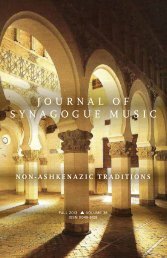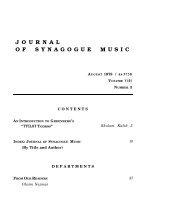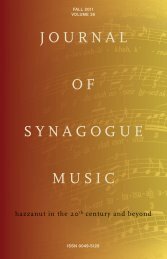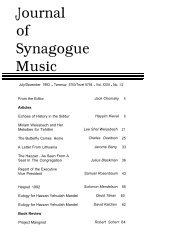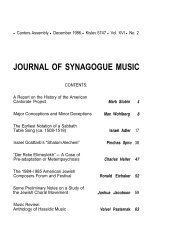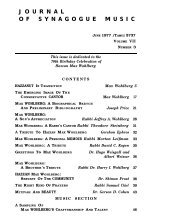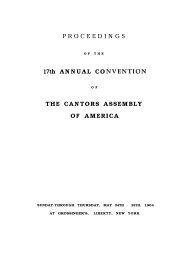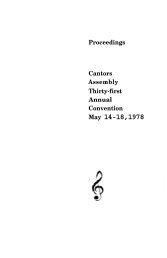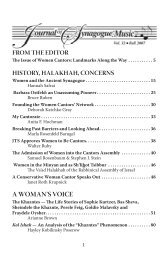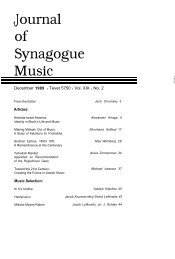ninth annual conference-convention - Cantors Assembly
ninth annual conference-convention - Cantors Assembly
ninth annual conference-convention - Cantors Assembly
Create successful ePaper yourself
Turn your PDF publications into a flip-book with our unique Google optimized e-Paper software.
most. This should go hand-in-hand with the general<br />
simplification of their rhythmic pattern which has become<br />
unduly complicated as a result of these melodic<br />
accretions.<br />
(2) While growing in their ornamentation, the Hebrew<br />
melodies of this type show a definite tendency<br />
towards increasing employment of semitones which<br />
seem to have occurred only occasionally, even ephemerally,<br />
in the ancient chants whenever they appeared<br />
at all. The gradual avoidance, and sometimes even<br />
a full suppression, of semitones would then be a logical<br />
procedure in any endeavor aiming at the restoration<br />
of the original melodies.<br />
(3) The expansion of the melodic range is another<br />
phenomenon which may ordinarily be observed with<br />
the growth of melodic ornamentation. Thus, the original<br />
span of an ancient chant that has hardly exceeded<br />
a fourth or a fifth, may easily expand to a sixth, a<br />
seventh, and occasionally even to larger intervals, as<br />
time goes on. Bringing the traditional chant back<br />
to its ancient status, in this respect, would naturally<br />
entail a gradual construction of its melodic range.<br />
(4) There is but a single feature in the traditional<br />
chant which, as a rule, remains relatively constant in<br />
its general outline, despite some inevitable local digressions<br />
caused by the specific changes enumerated<br />
in the foregoing three points. This is the basic direction<br />
of the melodic line, or its ‘curve’, or ‘profile’ as it<br />
has been variously named. Logically enough, one<br />
should exert the utmost effort to retain this particular<br />
feature, while stripping an ancient chant of elaborate<br />
adornments and thereby restoring its historically remote<br />
prototypes.<br />
The hypothetical restoration of the anciently used<br />
types of the Priestly Benediction on the basis of the<br />
above four points (as applied to the Sephardic chant<br />
under consideration) ultimately brought into more or<br />
less distinct relief six different ‘melodic layers’, as it<br />
were, wth a number of intermediate formations suggestively<br />
implied between them. Our composite musical<br />
illustration shows these six layers in orderly succession<br />
with the most complicated one (number 1) on<br />
the top and the simplest (number 6) close to the<br />
bottom.<br />
One will note at once that the upper layer, representing<br />
the latest version of the chant as actually<br />
sung by the Sephardic communities in Amsterdam, is<br />
a purely diatonic construction with melodic turns and<br />
cadence rather characteristic for a “Europeanized”<br />
product of the last three centuries or so. (Without<br />
any detriment to the chant itself, which is rhythmically<br />
free, I have taken the liberty to improve its general<br />
and somewhat inaccurate metric scheme as given in<br />
Rev. de Sola’s volume, so that the obvrously heavy<br />
points of the melody might legitimately fall on the<br />
initial parts of each measure.) This version (number<br />
1) contains as many as 55 notes within the range<br />
of a minor seventh, each of its components C, D, E,<br />
F, G, A, B flat-appearing at one time or another on<br />
the strong (or relatively strong) beats of the melody<br />
and therefore being of equal importance in it. In this<br />
- 32 -<br />
particular form, the chant<br />
use before the year 1650.<br />
could hardly have been in<br />
The next stage of the musical illustration, marked<br />
A, shows in smaller notes the Gregorian parallel which<br />
despite its far less elaborate ornamentation, as compared<br />
with the Sephardic Benediction, has basically<br />
the same melodic delineation. This is the Latin Benedicamus<br />
Domino (“Let us bless the Lord”), one of the<br />
concluding formulas in the Roman Catholic liturgy<br />
which in its inner sense and ritual function, though<br />
not completely in actual wording, is close enough to<br />
Yebarechecha Adonai (“May the Lord bless thee”) in<br />
the Jewish service. After all, both are nothing else<br />
but acts of blessing. We may note incidentally that<br />
the motif of the second Latin word (Domino), added<br />
here merely for completeness and marked off on top<br />
by a horizontal bracket, is practically identical with<br />
one of the motifs (marked off by a similar horizontal<br />
bracket) immediately following the syllable RE of the<br />
Hebrew Benediction.<br />
The lucky preservation of this Gregorian item is<br />
important for us in more than one respect: f i<br />
it suggests quite strongly that the Sephardic Priestly<br />
Benediction has indeed embodied some of the basic<br />
melodic elements characteristic of the ancient Hebrew<br />
music. For, simlar to many other Gregorian melodies,<br />
this one too must have been early taken over by the<br />
Church from the then still lingering musical repertoire<br />
of the Jerusalem Temple and adjusted (first plainly<br />
and later with certain elaborations) to Latin words.<br />
All of which would imply that both the medieval Benedicamus<br />
of the Roman liturgy and the Baroque-like<br />
Yebarechecha of the Amsterdam Jews had a common<br />
pre-Christian parent which was melodically simpler<br />
than either.<br />
Secondly, as a typical representative of the Middle<br />
Ages, the Gregorian item in question provides us with<br />
a certain clue concerning the historical dating of the<br />
various melodic layers-including, of course, the “common<br />
parent” just referred to-that are about to be<br />
divulged in our restoration. And, thirdly, this Gregorian<br />
item may serve us as one of the controlling devices<br />
in the actual machinery of our restorative procedure<br />
; for, a close inspection of its notation shows<br />
that, contrary to the equal importance of all scalenotes<br />
in the Sephardic chant, only the notes G, G, A<br />
(directly connected with word syllables) and the note<br />
D (prolonged by a dash or “horizontal epizema” under<br />
it) stand out prominently in the Gregorian Benediction.<br />
The remaining two notes B flat and E (especially<br />
the latter with its ephemeral “quilisma”) are of<br />
a lesser significance and perform a purely ornamental<br />
function while the note C which appears only in the<br />
melismatic ending of the Sephardic chant, absent in<br />
the Gregorian parallel, is automatically excluded<br />
therefrom.<br />
I have frankly availed myseelf of this particular<br />
clue in the Gregorian Benediction concerning the unequal<br />
importance of scale-notes while endeavoring to<br />
disclose the earlier melodic layers of the Hebrew<br />
chant. Thus, its next version (number 2) was ob-



